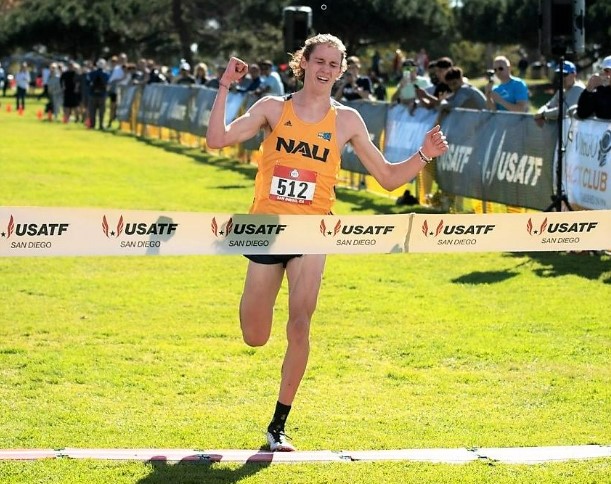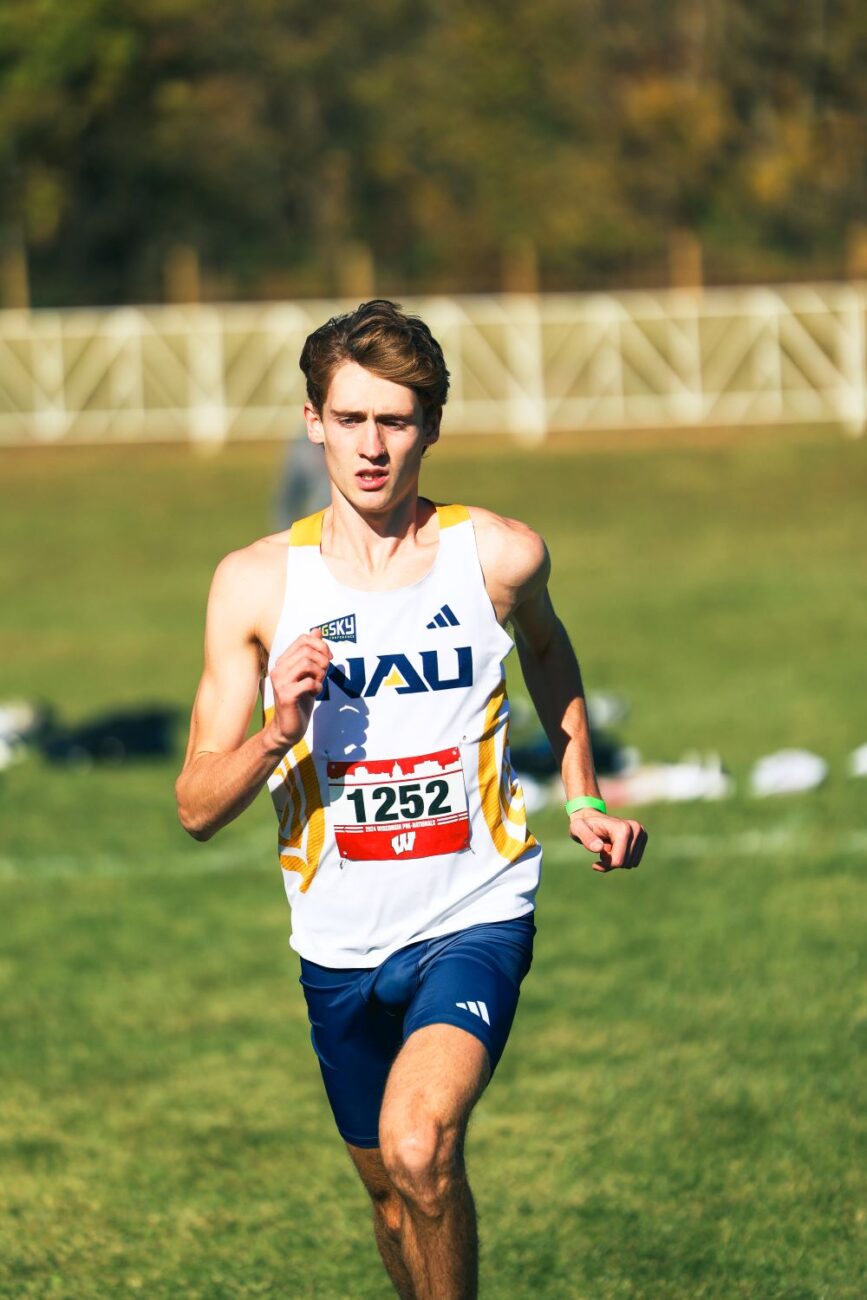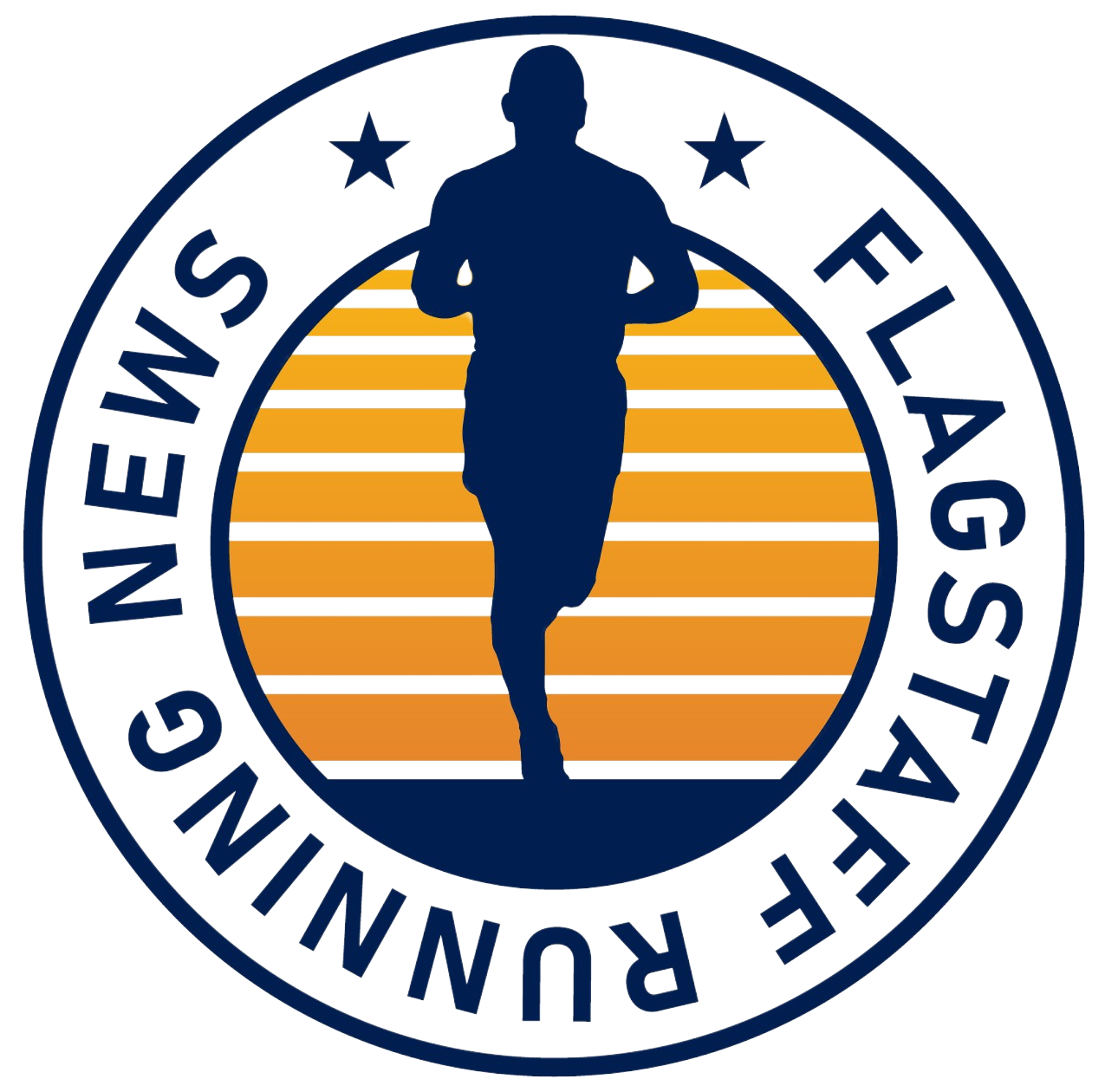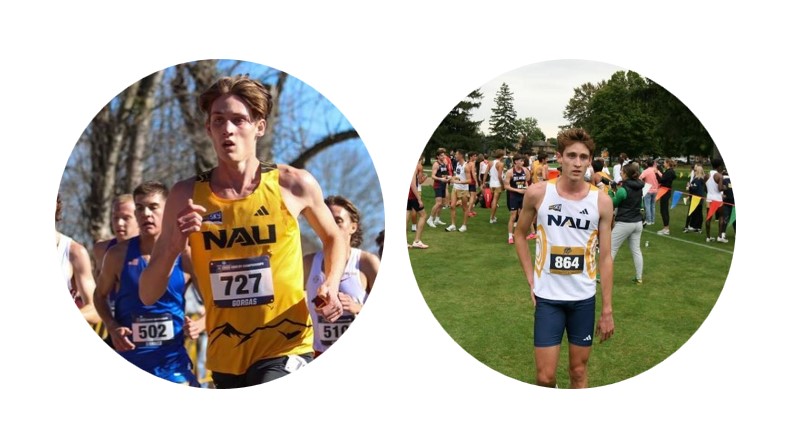Gorgas and the NAU men and women compete Friday at the Big Sky Conference Finals
In the Greek myth that constitutes Corey Gorgas’ college cross country plight at NAU, it would be easy, too easy, to equate it with the saga of Achilles, the warrior invulnerable to weakness except for that blasted heel that proved his undoing.
Perhaps a better mythological analogy regarding Gorgas might be that of Sisyphus, condemned to roll the boulder up a hill, only to have it roll back down and repeat the task for eternity, seen by many as an example of perseverance or, conversely, existential futility.
Gorgas’ career is no tragedy, for sure, and for the past two cross country seasons he has been physically able to be a big contributor to the Lumberjacks’ men’s team. But there are what-ifs wafting like an aura around Gorgas as he concludes his senior year (his sixth at NAU) with his final three meets – the Big Sky Conference Championships Friday in Pocatello, Idaho, the NCAA Mountain Regionals Nov. 15 in Reno and the NCAA Championships Nov. 23 in Madison, Wisc.
What if he hadn’t had a series of recurring Achilles tendon injuries, cropping up at the worst possible times like the Hydra-headed monster of Greek myth?
What if he could have overcome the chronic tendinopathy that forced him to spend more time cross training in the pool, on the Elliptical machine and strapped into the anti-Gravity treadmill than on the grass, dirt and pavement like his teammates?
What if, even now, he could do more than just one hard workout a week with the team before lining up for races?
These are rhetorical questions, of course, and though the personable and gracious Gorgas does admit to a little disappointment with how his college running has turned out, he has mostly come to terms that this is his reality, his new normal.
Frustrated, Corey?
“I try not to dwell on it,” he said, smiling wryly.
Put yourself in Gorgas’ spikes for a second. Here he was, one of the top high school runners in the nation in 2018-19, a ninth-place finisher at the Nike Cross Nationals, duking it out with future Olympians Cole Hocker and Nico Young and finishing 14 places higher than his future NAU teammate, Drew Bosley, in that race of prep superstars.
The upside for the native of Saugatuck, Mich., seemed limitless. He arrived in Flagstaff in the fall of 2019 and, though he was redshirted like almost all true freshmen under coach Mike Smith, Gorgas showed immediate promise. In January of 2020, he won Junior Men’s 8K Championship race at the 2020 USATF cross country nationals and then won U20 Pan American Games two months later in Langford, British Columbia.
Things looked klieg-lights bright for Gorgas at that point. NAU observers couldn’t wait until the next cross country season, when Gorgas would join newcomers Young and Bosley on an already packed Lumberjack men’s team.

It was at about that time, however, that the metaphorical arrow first pierced Gorgas’ Achilles tendons – yes, tendons (plural) on both legs, in alternating bouts of pain and debilitation.
Since then, it’s been a litany of stop-and-starts for Gorgas. He’d cross-train to stay in shape, sometimes logging nine hours a week working solo in the pool or elliptical, only to have that nagging tendinitis return when he tried to ramp up actual running and doing workouts.
Again, like Sisyphus, the cross training amounted to rolling the boulder up the hill, and the subsequent injury was the boulder rolling back down.
To Gorgas’ credit, though, he never stopped working and rehabbing to make comebacks that might have prompted someone less mentally strong to pack it in. Finally, in the 2023 cross country season, in which NAU’s men finished second nationally, Gorgas was able to compete.
He actually raced and raced well. He contributed to NAU’s scoring at the Pre-Nationals in Virginia, at the Nuttycombe Invitational in Wisconsin, placed fifth at the Big Sky Conference Championships and, in the NCAA finals, was NAU’s sixth runner in 62nd place.
Not bad, an outside observer might conclude, especially considering in the previous four years he had only competed in five races total. Not bad, and yet not what distance running aficionados expected from an erstwhile high-school star.
But what people did not know was just how hard Gorgas worked to put together a full season in 2023 – what a personal victory it was just to compete. The same holds true for this season. Gorgas has run, but it hasn’t at all been easy or routine.
He finished second at the Dave Murray Invitational in Tucson in September, was NAU’s fourth runner at the Joe Piane Invitational at Notre Dame, and the team’s fourth finisher at the Pre-Nationals two weeks ago. He’s done all, remember, that primarily via cross training and keeping Achilles’ flareups at bay.
“It’s primarily been Achilles issues, tendinopathies,” he said. “It just comes down to strength in the soleus and calf. … It’s changed every year. It’s been all over the place, both sides plenty of times. I’ve been mostly healthy this season. There’s been flare ups the last two weeks. This one (right) kind of the little upset right now, but nothing I can’t get through.”
He made it sound rather ordinary, and his outward reaction is one of stoicism, but the Achilles issues have been anything but routine. He did not have Haglund’s deformity in the heel, a la Galen Rupp and Tyler Day and other notables, so there was no surgical fix. It turned out, Gorgas just had to deal with recurring pain in alternating Achilles and somehow find the right balance of running and cross training.
Yes, he’s seen orthopedic doctors. Yes, he’s been to physical therapists. No, there’s been no definitive answer as to cause and treatment. For Gorgas, it’s been a multi-year case of seeing how fit he can get cross training and then seeing how far he can push his Achilles running before injury strikes once more.
He’s been told by medical experts that he needed to increase strength training to fortify his lower leg muscles and tendons.
“And I try my best to do that,” he said. “Strength training to be able to increase the load on the Achilles. Eventually, doing this week after week, loading it so many times over and over again, it always seems to catch up. Basically, the strength buys me a few extra weeks.”
It seemed, to outsiders, that it bought him a pretty much full 2023 in cross country season.
But …
“During the entire fall last year, I was on the Boost (anti-gravity treadmill) every day of the week except for workouts and races,” he explained. “I wasn’t running on land outside of the hardest effort on Friday and races. Each Friday, it’d set it back and flare up and I’d just manage it the rest of the week. In terms of races, yes, I competed. But behind the scenes, I’m in the pool five hours a week, on the Boost four or five hours.”
“I’m willing to put up with this (extreme cross training) for my team. But I don’t know if I want to put up with this for myself (as a pro). When I talk about running through injuries, which is what a lot of my college experience has been, I’ll go in the pool and get on the boost treadmill and be isolated in that environment for how many hours of the week it takes so that I can help the team and race and line up.”
Corey Gorgas
Training was a grind last year, and it mostly remains so this year. But he does it because it’s the only way he’s found that gets him healthy enough to race and — his main motivation — contribute to the team’s success.
Gorgas said Smith and his other coaches have “definitely been more inclined to hold me back in recent years as opposed to the earlier years I was here,” and he said he’s finally come to terms that he needs to hold back on heavy training to race at all.
That’s come, he said, with maturity.
“It was harder to make decisions like that my first couple of years,” he said. “I’ve matured more in the sport and been secure to be able to say no and be OK with missing things. I’ve found recently that less intensity in the training gets me better than if I were to do the more intense training — the really hard workouts that pose a higher risk to the Achilles. The overall volume I’ve found has been most helpful, the hours cross training and running — doing all that sets me up and I race myself into shape.”
This year, on a good week, Gorgas said he can log up to 60 miles per week running and five hours a week on the elliptical machine. He admitted, though, he feels it in his legs after donning the spikes and racing.
“That adds up to 12 hours,” he said. “I’m working the heart while protecting the legs. That’s a strength but at the same time it can come back and bite me — that I’m fit enough to complete these really hard workouts that maybe my legs aren’t quite adapted for.”

Gorgas is in NAU’s Masters’ program in psychological sciences and is finishing his thesis, a sample of Norwegian veterans of the war in Afghanistan exposed to combat and resulting PTSD and tobacco use. He said he got interested in the issue from visiting NAU professor Andreas Nordstand, a clinical psychologist in the Norwegian Armed Forces.
Though Gorgas soon will have his graduate degree and someday hopes to complete a doctorate in clinical psychology, he said he has no interest in specializing in sports psychology, despite his athletic endeavors.
“I can’t say I’ve used it (psychological principles) to help out on that end (dealing mentally with his Achilles injuries), which is ironic because I do eventually want to go into clinical work,” he said.
Given Gorgas’ innate running talent, might he want to delay his Ph.D ambitions and try a stab at post-collegiate pro running if his Achilles issues finally resolve?
In answer, Gorgas is nothing but realistic. Truth is, it’s been years now, and the Achilles problem has not gone away. He’s sticking with his main goals of scoring as high as he can this fall in the NCAA cross country nationals and staying healthy enough to finally be able to compete in outdoor track and perhaps make the nationals in the 10,000 meters.
“I’m willing to put up with this (extreme cross training) for my team,” he said. “But I don’t know if I want to put up with this for myself (as a pro). When I talk about running through injuries, which is what a lot of my college experience has been, I’ll go in the pool and get on the boost treadmill and be isolated in that environment for how many hours of the week it takes so that I can help the team and race and line up.
But …do I really want to keep putting myself through this if it’s not for the team and just (for) myself?”
Sisyphus may have asked the same question.


Leave a Reply